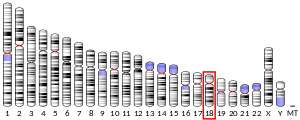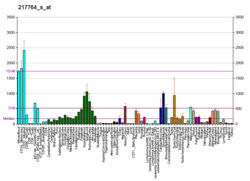RAB31
Ras-related protein Rab-31 is a protein that in humans is encoded by the RAB31 gene.[5][6]
References
- 1 2 3 GRCh38: Ensembl release 89: ENSG00000168461 - Ensembl, May 2017
- 1 2 3 GRCm38: Ensembl release 89: ENSMUSG00000056515 - Ensembl, May 2017
- ↑ "Human PubMed Reference:".
- ↑ "Mouse PubMed Reference:".
- ↑ Chen D, Guo J, Miki T, Tachibana M, Gahl WA (Nov 1996). "Molecular cloning of two novel rab genes from human melanocytes". Gene. 174 (1): 129–34. doi:10.1016/0378-1119(96)00509-4. PMID 8863739.
- ↑ "Entrez Gene: RAB31 RAB31, member RAS oncogene family".
Further reading
- Ng EL, Wang Y, Tang BL (2007). "Rab22B's role in trans-Golgi network membrane dynamics". Biochem. Biophys. Res. Commun. 361 (3): 751–7. doi:10.1016/j.bbrc.2007.07.076. PMID 17678623.
- Olsen JV, Blagoev B, Gnad F, et al. (2006). "Global, in vivo, and site-specific phosphorylation dynamics in signaling networks". Cell. 127 (3): 635–48. doi:10.1016/j.cell.2006.09.026. PMID 17081983.
- Kimura K, Wakamatsu A, Suzuki Y, et al. (2006). "Diversification of transcriptional modulation: large-scale identification and characterization of putative alternative promoters of human genes". Genome Res. 16 (1): 55–65. doi:10.1101/gr.4039406. PMC 1356129. PMID 16344560.
- Gerhard DS, Wagner L, Feingold EA, et al. (2004). "The status, quality, and expansion of the NIH full-length cDNA project: the Mammalian Gene Collection (MGC)". Genome Res. 14 (10B): 2121–7. doi:10.1101/gr.2596504. PMC 528928. PMID 15489334.
- Brandenberger R, Wei H, Zhang S, et al. (2005). "Transcriptome characterization elucidates signaling networks that control human ES cell growth and differentiation". Nat. Biotechnol. 22 (6): 707–16. doi:10.1038/nbt971. PMID 15146197.
- Strausberg RL, Feingold EA, Grouse LH, et al. (2003). "Generation and initial analysis of more than 15,000 full-length human and mouse cDNA sequences". Proc. Natl. Acad. Sci. U.S.A. 99 (26): 16899–903. doi:10.1073/pnas.242603899. PMC 139241. PMID 12477932.
- Bao X, Faris AE, Jang EK, Haslam RJ (2002). "Molecular cloning, bacterial expression and properties of Rab31 and Rab32". Eur. J. Biochem. 269 (1): 259–71. doi:10.1046/j.0014-2956.2001.02645.x. PMID 11784320.
- Suzuki Y, Yoshitomo-Nakagawa K, Maruyama K, et al. (1997). "Construction and characterization of a full length-enriched and a 5'-end-enriched cDNA library". Gene. 200 (1–2): 149–56. doi:10.1016/S0378-1119(97)00411-3. PMID 9373149.
- Bonaldo MF, Lennon G, Soares MB (1997). "Normalization and subtraction: two approaches to facilitate gene discovery". Genome Res. 6 (9): 791–806. doi:10.1101/gr.6.9.791. PMID 8889548.
- Maruyama K, Sugano S (1994). "Oligo-capping: a simple method to replace the cap structure of eukaryotic mRNAs with oligoribonucleotides". Gene. 138 (1–2): 171–4. doi:10.1016/0378-1119(94)90802-8. PMID 8125298.
- Osaka N (1975). "Target size and luminance in apparent brightness of the peripheral visual field". Perceptual and motor skills. 41 (1): 49–50. doi:10.2466/pms.1975.41.1.49. PMID 1178432.
This article is issued from
Wikipedia.
The text is licensed under Creative Commons - Attribution - Sharealike.
Additional terms may apply for the media files.








